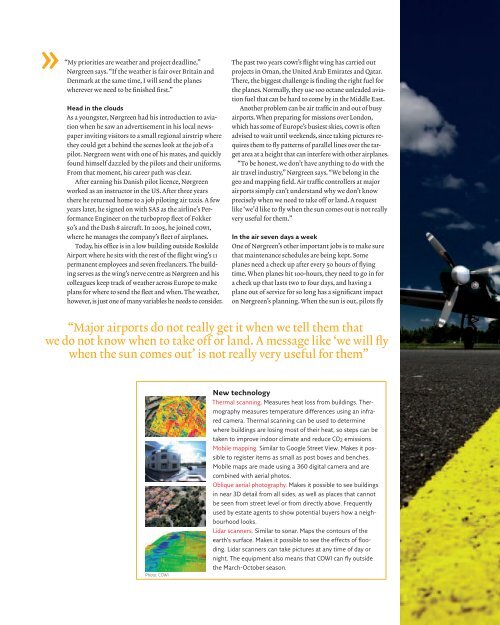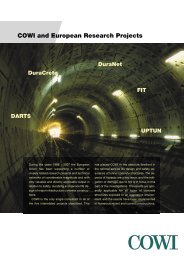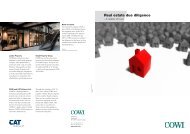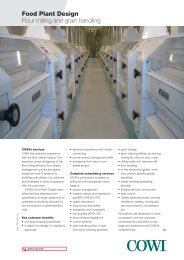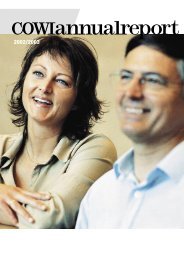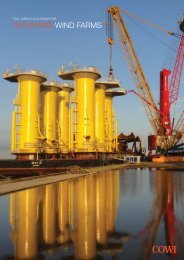Create successful ePaper yourself
Turn your PDF publications into a flip-book with our unique Google optimized e-Paper software.
Section Manager Per Nørgreen says that when it<br />
comes to planning COWI’s mapping flights, his list<br />
of priorities is wea<strong>the</strong>r, deadline and assignment.<br />
Photo: Das Büro<br />
“My priorities are wea<strong>the</strong>r and project deadline,”<br />
Nørgreen says. “If <strong>the</strong> wea<strong>the</strong>r is fair over Britain and<br />
Denmark at <strong>the</strong> same time, I will send <strong>the</strong> planes<br />
wherever we need to be finished first.”<br />
Head in <strong>the</strong> clouds<br />
As a youngster, Nørgreen had his introduction to aviation<br />
when he saw an advertisement in his local newspaper<br />
inviting visitors to a small regional airstrip where<br />
<strong>the</strong>y could get a behind <strong>the</strong> scenes look at <strong>the</strong> job of a<br />
pilot. Nørgreen went with one of his mates, and quickly<br />
found himself dazzled by <strong>the</strong> pilots and <strong>the</strong>ir uniforms.<br />
From that moment, his career path was clear.<br />
After earning his Danish pilot licence, Nørgreen<br />
worked as an instructor in <strong>the</strong> US. After three years<br />
<strong>the</strong>re he returned home to a job piloting air taxis. A few<br />
years later, he signed on with SAS as <strong>the</strong> airline’s Performance<br />
Engineer on <strong>the</strong> turboprop fleet of Fokker<br />
50’s and <strong>the</strong> Dash 8 aircraft. In 2005, he joined cowi,<br />
where he manages <strong>the</strong> company’s fleet of airplanes.<br />
Today, his office is in a low building outside Roskilde<br />
Airport where he sits with <strong>the</strong> rest of <strong>the</strong> flight wing’s 11<br />
permanent employees and seven freelancers. The building<br />
serves as <strong>the</strong> wing’s nerve centre as Nørgreen and his<br />
colleagues keep track of wea<strong>the</strong>r across Europe to make<br />
plans for where to send <strong>the</strong> fleet and when. The wea<strong>the</strong>r,<br />
however, is just one of many variables he needs to consider.<br />
The past two years cowi’s flight wing has carried out<br />
projects in Oman, <strong>the</strong> United Arab Emirates and Qatar.<br />
There, <strong>the</strong> biggest challenge is finding <strong>the</strong> right fuel for<br />
<strong>the</strong> planes. Normally, <strong>the</strong>y use 100 octane unleaded aviation<br />
fuel that can be hard to come by in <strong>the</strong> Middle East.<br />
Ano<strong>the</strong>r problem can be air traffic in and out of busy<br />
airports. When preparing for missions over London,<br />
which has some of Europe’s busiest skies, cowi is often<br />
advised to wait until weekends, since taking pictures requires<br />
<strong>the</strong>m to fly patterns of parallel lines over <strong>the</strong> target<br />
area at a height that can interfere with o<strong>the</strong>r airplanes.<br />
“To be honest, we don’t have anything to do with <strong>the</strong><br />
air travel industry,” Nørgreen says. “We belong in <strong>the</strong><br />
geo and mapping field. Air traffic controllers at major<br />
airports simply can’t understand why we don’t know<br />
precisely when we need to take off or land. A request<br />
like ‘we’d like to fly when <strong>the</strong> sun comes out is not really<br />
very useful for <strong>the</strong>m.”<br />
In <strong>the</strong> air seven days a week<br />
One of Nørgreen’s o<strong>the</strong>r important jobs is to make sure<br />
that maintenance schedules are being kept. Some<br />
planes need a check up after every 50 hours of flying<br />
time. When planes hit 100-hours, <strong>the</strong>y need to go in for<br />
a check up that lasts two to four days, and having a<br />
plane out of service for so long has a significant impact<br />
on Nørgreen’s planning. When <strong>the</strong> sun is out, pilots fly<br />
ten-hour missions, so it does not take long to rack up<br />
<strong>the</strong> hours. Making a schedule for pilots, he says, is<br />
almost a science in and of itself.<br />
“Our employees are away for<br />
weeks at a time, but just about all of<br />
<strong>the</strong>m have families, and that needs<br />
www.cowi.com/flight<br />
to be taken into consideration.” But<br />
during prime flying season from<br />
March to October, Nørgreen says he<br />
has planes flying seven days a week.<br />
“We need to fly as much as possible,<br />
and we cannot be making special<br />
See video from Roskilde Airport<br />
considerations just because it is a<br />
weekend or holiday.”<br />
Fighter escort<br />
The fascinating thing about his job is that all <strong>the</strong> pieces<br />
need to fall into place. It can be hard to get <strong>the</strong>m to fit,<br />
but working in <strong>the</strong> flight wing is enjoyable. He remembers<br />
that once, as a cowi plane was making its way<br />
through Dutch and German airspace on its way home<br />
from Britain during <strong>the</strong> 2006 World Cup, <strong>the</strong> pilot was<br />
asked by German air traffic controllers to change frequencies.<br />
The request, however, was never heard, and<br />
concerned about <strong>the</strong> threat of terrorism, <strong>the</strong> German air<br />
force dispatched two F-16s to make visual contact with<br />
<strong>the</strong> unresponsive airplane. They escorted <strong>the</strong> plane as<br />
“Major airports do not really get it when we tell <strong>the</strong>m that<br />
we do not know when to take off or land. A message like ‘we will fly<br />
when <strong>the</strong> sun comes out’ is not really very useful for <strong>the</strong>m”<br />
“We need to fly as much as possible, and<br />
we cannot be making special considerations just<br />
because it is a weekend or holiday”<br />
Photo: COWI<br />
New technology<br />
Thermal scanning. Measures heat loss from buildings. Thermography<br />
measures temperature differences using an infrared<br />
camera. Thermal scanning can be used to determine<br />
where buildings are losing most of <strong>the</strong>ir heat, so steps can be<br />
taken to improve indoor climate and reduce CO 2 emissions.<br />
Mobile mapping. Similar to Google Street View. Makes it possible<br />
to register items as small as post boxes and benches.<br />
Mobile maps are made using a 360 digital camera and are<br />
combined with aerial photos.<br />
Oblique aerial photography. Makes it possible to see buildings<br />
in near 3D detail from all sides, as well as places that cannot<br />
be seen from street level or from directly above. Frequently<br />
used by estate agents to show potential buyers how a neighbourhood<br />
looks.<br />
Lidar scanners. Similar to sonar. Maps <strong>the</strong> contours of <strong>the</strong><br />
earth’s surface. Makes it possible to see <strong>the</strong> effects of flooding.<br />
Lidar scanners can take pictures at any time of day or<br />
night. The equipment also means that COWI can fly outside<br />
<strong>the</strong> March-October season.<br />
it slowly made its way out of German airspace, even<br />
though <strong>the</strong>y were having trouble flying as slow as<br />
cowi’s propeller plane.<br />
@ Per<br />
Nørgreen, Section Manager,<br />
pno@cowi.com<br />
Two international projects<br />
cowi is mapping Serbia as part of a major EU project being<br />
carried out to reconstruct <strong>the</strong> country. The maps will help<br />
create a register of individual buildings and plots of land.<br />
In Sweden, cowi is working with <strong>the</strong> mapmakers at Blom to<br />
conduct laser scanning of <strong>the</strong> entire country. The informa-<br />
tion will be used to create a new elevation map that can<br />
be used to record where high-tension power lines are<br />
located, as well as to keep an eye on <strong>the</strong> condition of dikes<br />
and whe<strong>the</strong>r river valleys are drying out. In addition, urban<br />
planners and forestry managers will also be able to use <strong>the</strong><br />
information.<br />
International news magazine from cowi • 39


